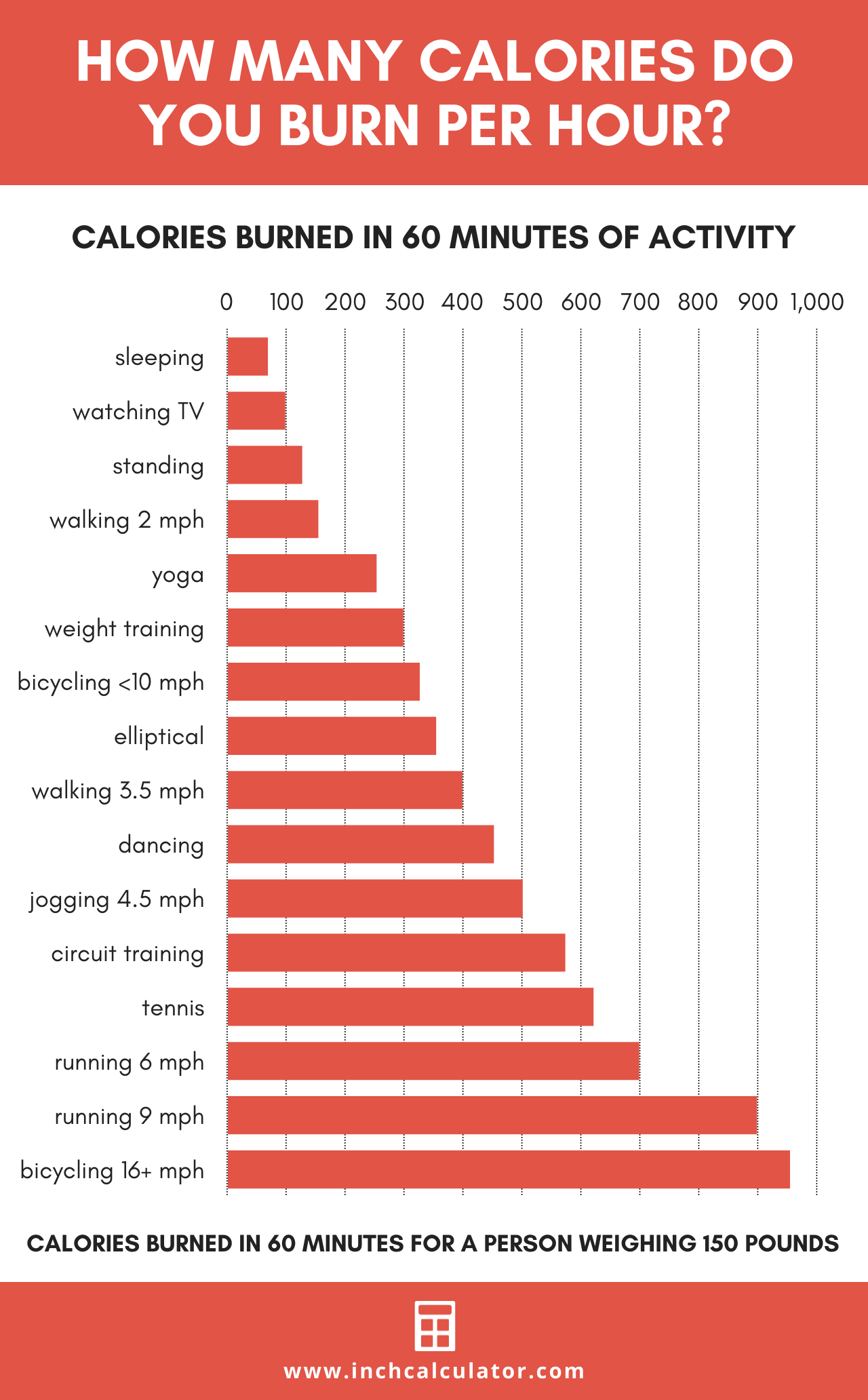Calories Burned Calculator
Calculate how many calories you burn for common exercises and activities by entering your weight and selecting an activity below.
Calories Burned by Activity:
Total Calories
Calories per Hour
On this page:
How Many Calories Do You Burn a Day?
Being health-conscious means that you need to know how many calories you burn in a day. Figuring out how much energy you expend any given day can help you determine how many calories you need to consume to either maintain a healthy weight, lose weight, or even gain lean muscle mass.
While you won’t burn exactly the same number of calories every day, you can calculate an estimation of your total daily energy expenditure (TDEE) based on your basal metabolic rate and your general level of activity.
How to Calculate TDEE
To calculate your TDEE, or the amount of energy you burn each day, you need to first determine your basal metabolic rate (BMR) using a BMR calculator. The most common formulas used for this equation are the Mifflin St Jeor[1] and Harris Benedict[2] equations, although there have been revisions over the years. to the latter.
By simply inputting your weight in kilograms, age, and gender, you can get a rough estimate of the number of calories that your body requires to function at rest.
After calculating your BMR, you then multiply this by an activity factor to establish your total daily energy expenditure. The activity factor is based on how much energy you use above your resting metabolic rate.
This chart provides a guide to determine what your individual activity factor is based on your lifestyle.
| Level of Activity | Example | Activity Factor |
|---|---|---|
| Sedentary | Little to no exercise, such as a desk job with no additional physical activity | 1.2 |
| Lightly Active | Light exercise 1-2 days/week | 1.375 |
| Moderately Active | Moderate exercise 3-5 days/week | 1.55 |
| Very Active | Hard exercise 6-7 days/week | 1.725 |
| Extremely Active | Hard daily exercise and physical job or two times a day training | 1.9 |
The TDEE formula is BMR x your activity factor.
TDEE = BMR × Activity Factor
How Many Calories Do You Burn Exercising?
Using an activity factor is a good way to estimate your total daily energy expenditure on any given day. However, you can also calculate the number of calories burned during specific activities based on the type of exercise and the intensity.
The energy expended during any activity can be expressed as a standard number; this is known as the metabolic equivalent of a task, or MET.
When your muscles move, they require oxygen to produce energy. Activities that require more energy will burn more calories.
The metabolic equivalent of a task is the ratio of the metabolic rate during exercise during a given activity compared to the metabolic rate at rest.
One metabolic equivalent is the amount of oxygen consumed while sitting at rest, or 3.5 milliliters of oxygen used per kilogram of body weight per minute.[3]
METs are used to calculate how many calories are burned during exercise and physical activity.
How to Calculate Calories Burned
To calculate calories burned during an activity, all you need to do is know the MET value of that activity, the amount of time spent doing the activity, and your current weight. This can then be used in the following formula to calculate the calories burned during that activity.
kcal = time [minutes] × ((MET × 3.5) × weight [kg] ÷ 200)
The Compendium of Physical Activities provides a comprehensive list of activities and their corresponding MET values.[4] Some common activities and their MET values are provided in the table below.
| Activity | MET Value |
|---|---|
| Sleeping | 0.95 |
| Sitting quietly watching TV | 1.3 |
| Walking, less than 2.0 mph | 2.0 |
| Yoga, Hatha | 2.5 |
| Resistance (weight) training | 3.5 |
| Bicycling, <10 mph | 4.0 |
| Elliptical trainer, moderate effort | 5.0 |
| Walking, 2.9 to 3.5 mph, uphill | 5.3 |
| Jogging, general | 7.0 |
| Circuit training, vigorous intensity | 8.0 |
| Running, 6 mph (10 min/mile) | 9.8 |
| Running, 8 mph (7.5 min/mile) | 11.8 |
| Bicycling, 16-19 mph | 12.0 |

Sample Calculations
Walking calories burned
For example, if you went for a slow walk for an hour, you could calculate the amount of calories burned during this activity by using the MET value above. First, you would need to divide your weight in pounds by 2.2, which will give you your weight in kilograms.
For a 180 pound person, weight in kilograms would be:
180 / 2.2 = 81.8 kg
By inserting this number into the calories burned equation, you would have:
kcal = time [minutes] × ((MET × 3.5) × weight [kg] ÷ 200)
kcal = 60 minutes × ((2.0 × 3.5) × 81.8 kg ÷ 200)
kcal = 172 calories
On the other hand, if you were to walk uphill at a faster pace, the MET value would be closer to 5.3. In this instance, you would burn:
kcal = 60 minutes × ((5.3 × 3.5) × 81.8 kg ÷ 200)
kcal = 455 calories
Jogging calories burned
Jogging is slightly more intense than walking, and will therefore burn more calories. For the same person, jogging (MET of 7.0) for 60 minutes would burn:
kcal = 60 minutes × ((7.0 × 3.5) × 81.8 kg ÷ 200)
kcal = 601 calories
Running calories burned
Increasing the pace to a run at a 7.5 minute per mile pace requires more oxygen consumption and will expend even more energy. (MET of 11.8)
kcal = 60 minutes × ((11.8 × 3.5) × 81.8 kg ÷ 200)
kcal = 1,013 calories
As you can see, the more intense or vigorous the activity, the more oxygen is consumed and more energy is expended. This all correlates to more calories being burned. You can also burn more calories by simply increasing the time spent doing each activity.
Biking and swimming are some other great activities that burn a lot of calories.
Using Calories Burned to Determine Calorie Intake
For people involved in fitness programs, figuring out how many calories they burn during exercise is a good way to gauge how many calories they should eat. On days that involve more intense physical activity, more calories will be burned.
Increasing physical activity is one way to aid with weight loss. Creating a calorie deficit of about 500 calories a day is a safe way to shed pounds. Since one pound is approximately 3,500 calories, this would result in losing about one pound a week.
However, it should be noted that this is only an estimate as there are a number of other factors that play a role in weight loss. Still, this provides a good guideline in a fitness program.
Studies have found that when exercise is sufficient to produce an energy deficit of 500–1,000 calories per day, substantial weight loss can occur.[5]
Also, the addition of physical activity to healthy eating substantially increases the odds of long-term weight-loss maintenance.[6]
While calculating your TDEE is a great way to estimate your daily calorie needs, using the MET equation may be even more helpful on days when you engage in more strenuous activity. This can give you an idea of how many calories you burn in each type of physical activity you participate in daily.
References
- Mifflin, M. D., St Jeor, S. T., Hill, L. A., Scott, B. J., Daugherty, S. A., & Koh, Y. O., A new predictive equation for resting energy expenditure in healthy individuals, The American journal of clinical nutrition, 1990, 51(2), 241-247. https://doi.org/10.1093/ajcn/51.2.241
- Roza, A. M., & Shizgal, H. M., The Harris Benedict equation reevaluated: resting energy requirements and the body cell mass, The American journal of clinical nutrition, 1984, 40(1), 168–182. https://doi.org/10.1093/ajcn/40.1.168
- Jetté, M., Sidney, K., & Blümchen, G., Metabolic equivalents (METS) in exercise testing, exercise prescription, and evaluation of functional capacity, Clinical cardiology, 1990, 13(8), 555–565. https://doi.org/10.1002/clc.4960130809
- Ainsworth BE, Haskell WL, Herrmann SD, Meckes N, Bassett Jr DR, Tudor-Locke C, Greer JL, Vezina J, Whitt-Glover MC, Leon AS, The Compendium of Physical Activities Tracking Guide, Healthy Lifestyles Research Center, College of Nursing & Health Innovation, Arizona State University, https://pacompendium.com/
- Mayo Clinic, Counting calories: Get back to weight-loss basics, https://www.mayoclinic.org/healthy-lifestyle/weight-loss/in-depth/calories/art-20048065
- Catenacci, V. A., & Wyatt, H. R., The role of physical activity in producing and maintaining weight loss, Nature Clinical Practice Endocrinology & Metabolism, 2007, 3(7), 518-529. https://www.nature.com/articles/ncpendmet0554


